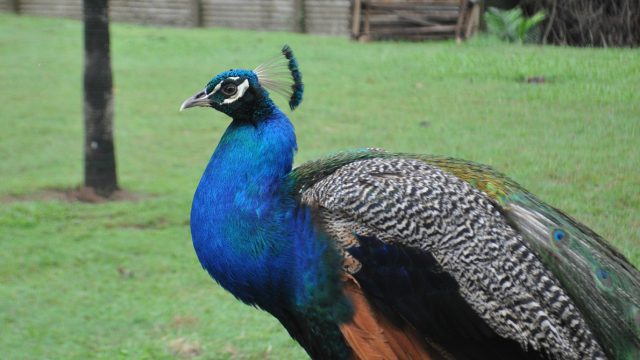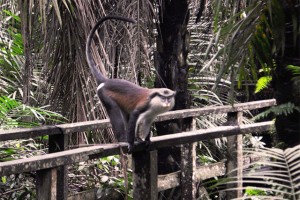The Lekki Conservation Centre—described on its website as “one of the few natural environment relics within the city”—must be, to use the cliché, one of Lagos’ best kept secrets. Most Lagosians have no idea that it exists, let alone visit, though it’s been in existence for some 25 years. That’s because they see Lagos as a completely built-up environment with no natural environment to spare.
But after taking just a few steps into the wild 78-hectare reserve, the sound of fast-moving vehicles—and the occasional honking that comes with it—recedes into the distance behind me, replaced by the occasional ripples from the swamp water underneath the boardwalk. Soon the noise is completely lost and I am fully in nature’s comforting embrace. This is quite incredible, considering that it’s just 16 km (10 mi) from the heart of a city renowned for its metropolitan grandeur and excessive population (official figures put it at 14 million).
The first thing I see as I step inside the LCC— which is divided into six sections—is a peacock sitting peacefully on the sign that shows the reserve’s layout. “Peacocks and tortoise are the only creatures you see roaming on the lawns in this open area,” one of the guides on duty tells me. “The rest are in the forest at the back—monkeys, crocodiles, name it.”
Impatient to see the animals with my own eyes, I hurry off onto the boardwalk trail, which stretches for 2 km into the reserve. The expanse of flora—left, right and above me—is so green, serene and calming I am not sure how to react, whether in excitement or in wonder. And other than the staff, already seated at their desks, there are no tourists about; the green haven is all mine to enjoy as I please. I pick my steps leisurely and do the best I can to pick up every little sound made by the leaves, which form a blanket above.
The first signboard at the head of the walkway provides an exciting clue to the treasures that lie within: “This is a nature reserve and not a zoo. Appreciate each moment! Observe the social interaction of the Mona monkeys. Catch a glimpse of the beautifully coloured birds and appreciate the variety of plants. Other animals that you might encounter include: squirrels, monitor lizards, crocodiles, crabs, pangolins and antelopes. This is indeed an ideal environment for education, research and pleasure.”
The first turn left on the boardwalk leads to a “swamp lookout,” a rectangular space roofed with raffia where tourists can watch birds, see aquatic animals and also take a short rest. Further up the trail, I reach the bird hide, a wooden enclosure with a horizontal line of small windows, through which tourists can look into the distance and watch out for birds like the blue-breasted kingfisher, the red-tip crested turaco, and the collared sunbird, among others species.
But much as I try to spot one, there is no bird in sight. All I see, aside from the plant species that ring the natural pool, is the sole monitor lizard perched on a stump and doing its best to evade my lens. As I photograph the scene in front of me, an in-house guide doing routine checks walks in. He is out inspecting the trail to see if there is damages to any of the sections which might need fixing, or an emergency which require prompt attention of the centre’s management. As of now there is no cause for alarm.
“This is an excellent spot to view migratory birds that fly down here from different parts of the world,” he says flatly. “But now is not the season.” Season permitting, the other fauna to be found here include egrets, herons, crabs, squirrels, snakes and (giant) rats. In a moment he is off to continue his patrol. I stay back for a while myself, admiring the water-lilies and the mangrove in all its richness.
An hour later, after walking through a couple of rest stops along the trial, I reach the Nature Station, where tourists can relax and picnic if they so please. Being a one-man party, I don’t think I need to use the facility. I take the next right turn and stroll to the tree-house, hanging at the top of a Pakia biglobossa 25m tall. It is, well, standing desolate, and for whatever reason I am not inspired to climb all the way up. I simply stay there awhile and then move towards the exit.
That’s when I spot the Mona monkey, leaping from one tree branch to the next, obviously in search of breakfast. As it turns out, it is my first—and only—wildlife spotting of the day, which doesn’t quite sit well with me and a concern I share with the guide I meet as I exit the reserve.
“On a good day you should see so many more animals—snakes, antelopes and all,” she says, apparently sensing my disappointment and trying her best to assure me that my time at the reserve has been worth it, whether or not I appreciate the fact. “But then the whole idea of this place is not to just come and see wildlife. It is also to enjoy the environment as it.”
I appreciate the young guide’s efforts to make me feel good and I do all I can to appear so. Truth be told, spending two leisurely hours inside the LCC has been rather refreshing; but deep within me I know I am not going to have that sense of fulfillment until I have seen some more wildlife.
I will be back someday soon, and when I do I hope that it is the perfect season and the animals are out and about.


